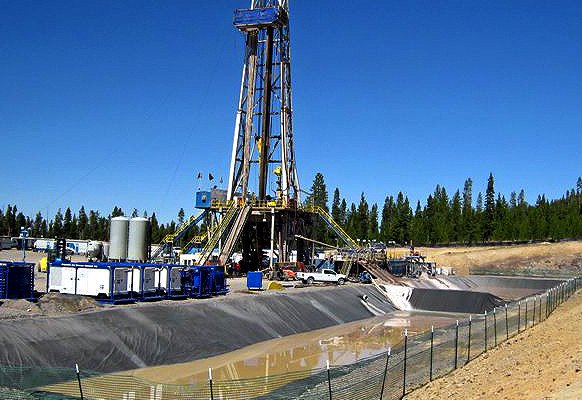Question: I've heard a lot of discussion about fracking. What is it, and how is BTL Liners involved? Answer: Fracking, or hydraulic fracturing, is a method whereby oil and gas that is found in shale and “tight,” or impermeable rock formations is recovered. While this technology has been used for quite some time in oil & gas drilling, recent advances to the process have unlocked huge deposits of oil and gas that were previously considered inaccessible or economically unfeasible to develop. The process of fracking has always involved drilling a very deep well, as much as 1.5 miles deep, far below the water table. Current technology now allows a horizontal bore to be drilled. This horizontal bore can be fractured in stages, using water and chemicals injected under extremely high pressure. The fracturing produces tiny cracks in the rock formation. The cracks are held open by tiny particles of sand that are mixed with the solution, thereby allowing the oil or gas to flow to the wellbore, where it can be pumped out in a more traditional fashion. There is currently much discussion about the risks of fracking, with particular discussion regarding the types of chemicals and additives used in fracking fluids. Experts believe that since the process takes place so far below the water table, there is actually very little risk involved of contaminating groundwater. The highest risk of contamination and environmental damage occurs when the used fluid is pumped back up and stored, either for future use in new fracking processes, or for disposal. Any fluid that is spilled during pumping soaks directly into the soil, immediately affecting surface water, such as lakes and streams, and eventually reaching the water table. BTL's role in the oil & gas industry is to provide impermeable liners for the safe storage & containment of fracking fluids. Proper storage includes dependable primary storage and full secondary containment systems to handle any leaks or spills due to equipment failure or human error. BTL provides high quality, custom made liners that are strong, durable, resistant to tears or punctures, that can be easily configured to meet the demands of any location and any style of frac tank. With proper setup & installation, coupled with appropriate monitoring and safety procedures, we believe that hydraulic fracturing is a fundamentally safe process. BTL Liners has worked for several decades with National Oilwell Varco (NOV), and has played an integral role in the development of the newly designed frac tanks of the last several years. We are proud to play a role in the development and production of energy resources here in the United States, which we believe benefits both the economy and security for all of North America.
What is Fracking?
AquaArmor Pond Liner
The most versatile liner on the market today, AquaArmor maximizes protection from harmful UV rays, tear resistance and punctures that cause leaks. Simply the best liner on the market.Newest Articles:
Subscribe to Updates
Article Topics
Agriculture
Covers
Tarps
Aquaponics
Energy
Liners
Hydroponics
Greenhouse Light Deprivation
Water Gardens
Farm Ponds
Greenhouses
Greenhouse Gardening
Greenhouse Cover
Fish Pond
Pond
Fish
Golf Course Pond
Golf Course Water Feature
Natural Pond
Landfill Cover
Irrigation
Irrigation Pond
Irrigation Canal
Hydraulic Fracturing
Oil Containment
Secondary Containment
Fracking
Oil Liner
Fuel Liner
Frac Pit
Fire Protection Pond
Fire Suppression Pond
Fire Pond
Geomembrane
Canal Liner
Brine Pond
Koi Pond
Algae Pond
Nursery Pond
Retention Pond
Man-Made Lake
Lakes
Geothermal Greenhouse
Commercial Greenhouse
Preformed Pond Liner
Groundwater Storage Lagoon
Mining Pond
Mining Lagoon
Evaporation Pond
Salt Pond
Pond Liner Materials
Catch Basin
Stormwater Management
Barren Pond
Processing Pond
Natural Swimming Pond
Drainage Systems
Ditch Lining
Aquaculture
Sewage Lagoon
Mining Geomembranes
Floating Cover
Wastewater Containment
Geosynthetics
Cistern Lining
Erosion Control
Fertilizer Containment
Winery Water
Silage Cover
Winery Irrigation Pond
Baseball Field Cover
Tailings Pond
Produced Water Liner
Produced Water Winery
Construction Pond
Winter Ponds
Fish Hatchery
Algae Raceways
Coal Ash Containment
Fishing Lakes
Oilfield Pits
Aquatic Habitats
Lake Restoration
Landfill Cell Liners and Cap Covers
Leachate Pond
Rain Cover
Heap Leach Pads
Residential Ponds
Gas Collection
California Drought
California Pond Liner
Overburden Containment
Pond Liner
Fish Stocking Pond
Mine Reclamation
Wastewater Cover
Drought
Irrigation Reservoir
Sludge Management
Cable Parks
Baffle Systems
Alternative Daily Covers
Reservoir Pond
Aeroponics
Food Shortages
Homesteading
Prepping
Toxic Waste
Potable Water Storage
Green Roof
Clearwells
Stormwater Harvesting
Snow Making Ponds
Pond Plants
Hunting Ponds
Oregon Pond Liner
Lavender
Site Runoff Containment
EPDM Liners
Duck Hunting Pond
Deer Hunting Pond
Decorative Ponds
Methane Capture
Large Pond
Sports Field Liner
California Fire Pond
Helicopter Dip Pond
Oregon Fire Pond
Pond Skimming
Geotextile Fabric
Silt Fences
Backyard Greenhouses
DIY Greenhouse
RPE Liners
Desalination
Controlled Environment Agriculture
Living Roofs
Dairy Lagoons
Tank Farm
Wastewater Treatment
Self-Sufficiency
Wicking Bed Liners
Hay Covers
Grow Bed Liner
Light Deprivation Greenhouses
Dam Lining
Frac Pad Liners
Geothermal Energy
Coal Mining
Farming Ground Cloth
Gardening Ground Cloth
Waterfowl Impoundment
Reinforced Polyethylene
Winery Wastewater Management




